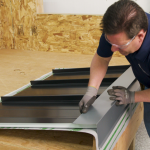Identifying Asbestos in Navy Dependent Housing
Many older homes on Navy bases were built during a time when asbestos was a common building material. This means that asbestos-containing materials (ACMs) could be present in various parts of your housing. Recognizing the potential for asbestos is the first step in protecting your family’s health.
Common Locations of Asbestos-Containing Materials
Asbestos was added to many products to make them stronger, more durable, and resistant to heat and electricity. In residential settings, you might find it in:
- Insulation: Particularly in attics, crawl spaces, and around pipes and heating systems.
- Flooring: Vinyl tiles and the adhesive used to secure them often contained asbestos.
- Ceiling tiles: Many textured or acoustic ceiling tiles used in the mid-20th century are ACMs.
- Textured paints and coatings: Some older popcorn ceilings or decorative wall coatings can contain asbestos fibers.
- Roofing and siding materials: Shingles and exterior cement products were frequently made with asbestos.
Recognizing Potential Asbestos Hazards
Asbestos materials are generally safe when they are intact and undisturbed. The danger arises when these materials become damaged or deteriorated, releasing microscopic fibers into the air. Look out for:
- Cracked or crumbling materials: This is a clear sign that asbestos fibers may be becoming airborne.
- Water-damaged areas: Leaks can cause insulation or ceiling materials to break down.
- Materials that have been disturbed: Renovation or repair work, even minor, can disturb asbestos if not handled properly.
It’s important to remember that asbestos can be difficult to identify by sight alone. If you suspect a material contains asbestos, it is best to assume it does until professional testing confirms otherwise. Families affected by asbestos exposure on military bases can explore their legal options to seek compensation and justice [8dad].
The History of Asbestos Use in Military Housing
From the 1930s through the 1970s, asbestos was a go-to material for construction across the United States, including on military installations. Its fire-resistant and insulating properties made it seem like an ideal choice for building durable housing quickly and affordably. This widespread use means that many older military housing units, including those on Navy bases, likely contain asbestos. Asbestos was widely used in buildings, vehicles, and equipment on military bases, leading to widespread contamination [cbe3].
Health Risks Associated with Navy Dependent Housing Asbestos Exposure
Understanding Asbestos-Related Diseases
Exposure to asbestos fibers, often found in older building materials, can lead to serious health problems. When asbestos-containing materials are disturbed, tiny fibers become airborne and can be inhaled. These fibers can lodge in the lungs and other tissues, causing inflammation and scarring over time. The most well-known diseases linked to asbestos exposure are mesothelioma, lung cancer, and asbestosis.
- Mesothelioma: A rare but aggressive cancer that affects the lining of the lungs, chest, abdomen, or heart. It is almost exclusively caused by asbestos exposure.
- Lung Cancer: Asbestos exposure significantly increases the risk of developing lung cancer, even in individuals who have never smoked. The risk is even higher for smokers who have also been exposed to asbestos.
- Asbestosis: A chronic lung disease characterized by scarring of lung tissue, which can lead to shortness of breath, persistent cough, and chest pain.
Latency Periods and Symptoms
One of the most challenging aspects of asbestos-related diseases is their long latency period. This means that symptoms may not appear for many years, often 10 to 40 years or even longer, after the initial exposure. This delayed onset can make it difficult to connect current health issues to past exposure, especially in environments like military housing where families may move frequently.
Symptoms can vary depending on the specific disease, but common signs include:
- Persistent cough
- Shortness of breath or difficulty breathing
- Chest pain or tightness
- Unexplained weight loss
- Fatigue
- Dry, crackling sounds in the lungs during inhalation
Vulnerable Populations in Military Housing
Certain groups within Navy dependent housing may be at higher risk due to prolonged exposure or specific living conditions. Children, for instance, are particularly vulnerable because their developing bodies and lungs may be more susceptible to the long-term effects of asbestos fibers. Families living in older housing units that have not undergone proper asbestos abatement are also at increased risk. The cumulative nature of exposure means that the longer someone lives in an affected environment, the greater their potential risk.
Your Rights and Responsibilities Regarding Navy Dependent Housing Asbestos
Tenant Rights in Military Housing
When living in Navy dependent housing, residents have certain rights concerning the safety of their living environment. Landlords, including the military housing authorities, have a duty to provide safe and habitable housing. This means they are responsible for identifying and managing known hazards, including asbestos-containing materials (ACMs). Tenants have the right to be informed about potential asbestos in their homes and to have it addressed if it poses a risk. This includes the right to request inspections and to receive information about any asbestos testing that has been done. If you suspect asbestos, you have the right to report it without fear of reprisal.
Landlord Responsibilities for Hazardous Materials
The responsibilities of landlords in military housing extend to managing hazardous materials like asbestos. This involves:
- Inspection and Identification: Regularly inspecting properties for potential hazards, including ACMs, especially during renovations or when issues arise.
- Risk Assessment: Evaluating the condition of ACMs to determine if they are damaged and likely to release fibers.
- Management and Abatement: Developing and implementing plans to manage or safely remove asbestos when it is disturbed or poses a risk. This often requires hiring licensed professionals.
- Notification: Informing residents about the presence of asbestos and the steps being taken to manage it.
Reporting Suspected Asbestos Issues
If you believe there is asbestos in your Navy dependent housing, it is important to report it promptly and properly. The process typically involves:
- Document Everything: Keep records of any visible damage to materials you suspect contain asbestos, such as crumbling insulation or damaged tiles. Note the date you observed the issue.
- Formal Notification: Submit a written request to your housing management office or the relevant Navy housing authority. Clearly state your concerns and request an inspection for asbestos.
- Follow Up: If you do not receive a timely response or adequate action, follow up in writing. Keep copies of all correspondence.
- Escalate if Necessary: If the issue remains unaddressed, you may need to explore further avenues, such as contacting a tenant advocacy group or seeking legal advice.
Navigating the Process of Asbestos Remediation
Professional Asbestos Testing and Inspection
When asbestos is suspected in Navy dependent housing, the first step is always professional testing. This isn’t a DIY job; it requires trained and certified inspectors. They know where to look for materials that might contain asbestos and how to take samples safely. These samples are then sent to a lab for analysis. The results of this testing will determine if asbestos is present and in what quantities. Without this professional assessment, any remediation efforts could be ineffective or even dangerous.
Safe Removal and Abatement Procedures
If asbestos is confirmed, removal or abatement is necessary. This process must be handled by licensed asbestos abatement professionals. They follow strict protocols to prevent the release of asbestos fibers into the air. These procedures typically involve:
- Containing the work area with plastic sheeting and negative air pressure machines.
- Wetting the asbestos-containing materials to minimize dust.
- Carefully removing the materials and sealing them in special bags.
- Cleaning the area thoroughly using specialized vacuums.
It’s important to understand that abatement doesn’t always mean complete removal. Sometimes, asbestos materials are sealed or enclosed to prevent fiber release, which is also a form of remediation.
Post-Remediation Verification
After the abatement work is finished, a crucial step is post-remediation verification. This usually involves air testing conducted by an independent third party. The purpose of this testing is to confirm that the air in the living space is free of asbestos fibers and safe for reoccupation. Only when the air samples meet regulatory standards can the containment be removed and the area declared safe. This verification step is vital to protect the health of residents.
Seeking Legal Recourse for Asbestos Exposure
When to Consult an Attorney
If you or a family member has been diagnosed with an asbestos-related illness, and you suspect exposure occurred in Navy dependent housing, it is advisable to seek legal counsel. Consulting with an attorney experienced in asbestos litigation is a critical step. Such professionals can assess the specifics of your situation, including the timeline of your residency, the potential presence of asbestos in your former housing, and the medical evidence supporting your diagnosis. They can help determine if a viable legal claim exists.
Types of Legal Claims for Asbestos Exposure
Legal claims related to asbestos exposure often fall under personal injury law. These claims typically allege negligence on the part of those responsible for the housing and its maintenance. Common legal avenues include:
- Personal Injury Lawsuits: Filed by individuals who have suffered harm due to asbestos exposure.
- Wrongful Death Lawsuits: Filed by the family of someone who died as a result of an asbestos-related disease.
- Exposure Claims: Focusing on the period and location of exposure, linking it to the subsequent illness.
Gathering Evidence for Your Case
Building a strong case requires meticulous evidence collection. This process can be complex, but an attorney can guide you. Key types of evidence include:
- Medical Records: Documenting your diagnosis and the link to asbestos exposure.
- Housing Records: Proof of residency in specific Navy housing units during relevant periods.
- Photographic or Video Evidence: If available, showing the condition of the housing and potential asbestos-containing materials.
- Witness Testimony: Statements from former residents or maintenance personnel who can attest to the presence of asbestos or poor living conditions.
- Expert Reports: Opinions from medical and environmental experts to support your claim.
Preventative Measures for Navy Families
Minimizing Exposure in Existing Housing
Even when living in older housing, families can take steps to reduce potential asbestos exposure. Regularly inspect the condition of building materials for signs of damage, such as fraying insulation, crumbling tiles, or peeling paint. If any suspect materials are found, avoid disturbing them. Do not attempt to clean, repair, or remove them yourself, as this can release asbestos fibers into the air. Instead, report these findings immediately to the housing authority. Keeping living spaces clean with wet dusting and HEPA-filtered vacuums can also help capture any stray fibers that may have become airborne. Limit access to areas where asbestos-containing materials are known or suspected to be present, especially for young children who may be more prone to touching and ingesting debris.
Advocating for Safer Housing Standards
Military families have a role in pushing for better housing conditions. This can involve participating in tenant surveys, attending housing town halls, and communicating concerns directly to base housing officials and elected representatives. Sharing experiences and data about the prevalence of asbestos and other hazards can build a stronger case for policy changes. Advocating for stricter building codes and more frequent inspections in military housing can help prevent future exposure risks. Supporting initiatives that prioritize the health and safety of service members and their families is a collective effort that can lead to lasting improvements in housing quality across all branches of the military.
Resources for Military Families
Several organizations and government agencies offer support and information for military families dealing with housing issues, including asbestos concerns. The Military Housing Association (MHA) provides resources and advocacy for better housing. The Environmental Protection Agency (EPA) offers guidance on asbestos identification and safe handling. Additionally, local health departments can provide information on testing and remediation services. Families facing health issues potentially related to asbestos exposure should consult with their healthcare providers and consider seeking legal advice from attorneys specializing in asbestos litigation. Connecting with other military families who have navigated similar situations can also provide emotional support and practical advice.
Read More














